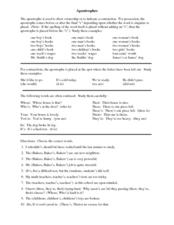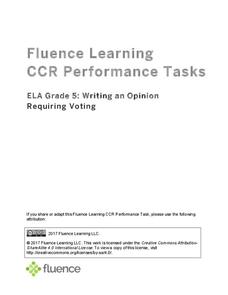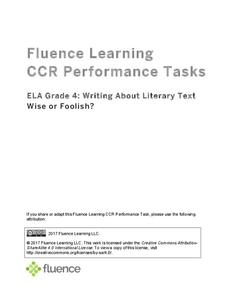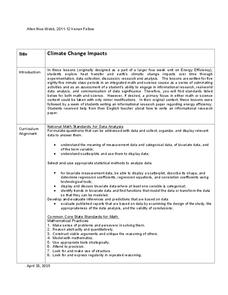Curated OER
Big Boats Up The River
Using boats along in the Port of Albany as the focus, learners practice adding single-digit numbers and interpreting data. This lesson plan comes with the worksheets, resource links, and other materials to make it a worthwhile experience.
Curated OER
Looking Ahead: Writing Prompt
This writing prompt spans nine slides and encourages learners to discuss or write about how they feel about moving on to 5th grade. It is a great way to engage self-assessment, reflection, personal motivation, and fluid writing skills.
Curated OER
Apostrophes and Quotation Marks
After a brief explanation of two uses for apostrophes (ownership and contractions) learners are asked to choose the correct word in 10 sentences. The same pattern is repeated for the use of quotation marks. The worksheet could be...
Hawaiʻi State Department of Education
ABA Form in Music
Patterns happen everywhere, in music, math, and language! Fourth graders listen to the "William Tell Overture" visualizing the patterns that they hear. They then discuss and write an ABA poem that matches the ABA form found in the music...
San José State University
Coordinating Conjunctions
As a review of coordinating conjunctions, this short activity could be useful. Learners are required to use a coordinating conjunction to combine two sentences in this 8 question activity.
Curated OER
Organizing and Understanding data - Guided Lesson Explanations
A teacher resource, this scripted lesson details how to explain to learners the steps involved in determining the total number of objects in a category, how many of each type, and how many more or less are in one category than in...
Curated OER
Finish the Picture
Explore positional prepositions as learners follow directions by adding four details to this picture of a fairy. Each instruction includes both an object and its location, so scholars get plenty of review. Consider also allowing them to...
Curated OER
Matching the Shapes
Which of these blocks match? As they learn about shape attributes and the term same, scholars draw lines from block formations on the left to the same shapes on the right. The eight starting shapes are split into two sections to...
Curated OER
Teacher Lesson Plans - Absolute Beginner English - 20 Point Program
Students who are at the beginning level of acquiring English benefit from this series of worksheets that address the very basics of learning how to use conversational English.
Curated OER
Teaching Telephone English for Business ESP English Classes
Students practice the practical skill of telephone communication. They perform a series of role plays to give them practical experience in the proper way to speak and respond while on the telephone.
Curated OER
My Reading Words in My Social Studies Book?
Connect social studies and language arts using this resource. After studying root words, have learners locate five words from their social studies book that have a prefix, suffix, or root word. This puts a new twist on practicing basic...
Fluence Learning
Writing an Argument: Is Electronic Communication Helpful or Harmful?
Technology has undoubtedly improved the lives of people around the world—but has it improved communication? Seventh graders read two informative passages about the rise of texting and emailing versus in-person conversations before...
Fluence Learning
Writing About Informational Text: Beyond the Beyond—Galaxies
Everyone has a different point of view, even when it comes to the enormity of the universe. Two separate text passages explain the scope of a galaxy, prompting young readers to write an essay about each author's argument and how the...
Fluence Learning
Writing an Opinion Requiring Voting
Challenge writers to compose an essay detailing their stance on, and the history of, voting. Three assignments, each broken down into three parts, requires fifth graders to take notes, read and complete charts, write paragraphs, compare...
Fluence Learning
Writing About Literary Text: Wise or Foolish?
A three-part assessment promotes reading comprehension skills. Class members read literary texts and take notes to discuss their findings, answer comprehension questions, write summaries, and complete charts.
K5 Learning
Saving the Birds
Learn about the kindness and strength of Abraham Lincoln with a reading comprehension activity. After third and fourth graders read a short story about Lincoln saving a family of robins, they answer four questions about the plot and...
K5 Learning
Androclus and the Lion
Kindness is never a standalone act. Fourth graders read the classic tale of Androclus and his act of service to the lion, which is repaid to him by the lion in a Roman colosseum. After reading the passage, they answer four comprehension...
Balanced Assessment
The Triskaidecaphobia Conference
Triskaidecaphobia is an extreme superstition to the number 13—and ironically the answer to the word problem is 13! Presented with a series of descriptive data, individuals analyze the data to determine the population size. They...
Kenan Fellows
Climate Change Impacts
Turn up the heat! Young mathematicians develop models to represent different climates and collect temperature data. They analyze the data with regression and residual applications. Using that information, they make conclusions about...
K5 Learning
The Merchant's Caravan
Scholars show what they know about a reading passage, The Merchant's Caravan, by way of four short answer questions designed to reinforce reading comprehension skills.
K5 Learning
The Bee
See what all the buzz is about with a reading comprehension activity! Third and fourth graders read a short informational passage about bees before answering four questions about what they have learned.
K5 Learning
Here Is A Nest
Answer the what, the how, and the why in a reading passage about a hen and her chicks. Readers use the text as a basis for finding the exact answers within the passage.
K5 Learning
Fire Alarm
Read about the safety of a fire alarm in a five-paragraph reading passage. After reading, pupils respond to four short answer, comprehension questions.
K5 Learning
Ten Little Cookies
First there were ten cookies and then there were none. Who ate all the cookies? After reading a short poem that counts down from 10 as cookies are eaten, class members respond to four comprehsnion questions.























